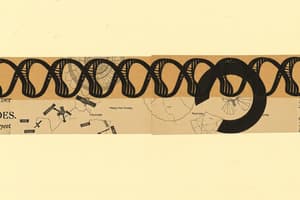Podcast
Questions and Answers
Which process involves the separation of sister chromatids into individual chromosomes?
Which process involves the separation of sister chromatids into individual chromosomes?
- Mitosis (correct)
- Prophase
- Cytokinesis
- Meiosis
What is the final stage of mitosis when sister chromatids begin to decondense and become long and thin?
What is the final stage of mitosis when sister chromatids begin to decondense and become long and thin?
- Telophase (correct)
- Prophase
- Metaphase
- Anaphase
During which phase of cell division does the spindle apparatus get disassembled?
During which phase of cell division does the spindle apparatus get disassembled?
- Metaphase
- Anaphase
- Telophase (correct)
- Prophase
In which process is there a reduction division of nuclear material resulting in gametes with half the parental hereditary material?
In which process is there a reduction division of nuclear material resulting in gametes with half the parental hereditary material?
Which type of cell division occurs only in gonads?
Which type of cell division occurs only in gonads?
What is the equatorial plane in mitosis?
What is the equatorial plane in mitosis?
During which stage of mitosis do the centromeres divide, separating sister chromatids?
During which stage of mitosis do the centromeres divide, separating sister chromatids?
What event characterizes cytokinesis in mitosis?
What event characterizes cytokinesis in mitosis?
What is responsible for the motion of divided centromeres with sister chromatids in anaphase?
What is responsible for the motion of divided centromeres with sister chromatids in anaphase?
What structure is responsible for forming the mitotic spindle in animal cells?
What structure is responsible for forming the mitotic spindle in animal cells?
At what point does the furrow in cytokinesis appear more deeply due to contraction of a ring of actin filaments?
At what point does the furrow in cytokinesis appear more deeply due to contraction of a ring of actin filaments?
Which stage of the cell cycle is characterized by the duplication of cellular contents excluding the chromosomes?
Which stage of the cell cycle is characterized by the duplication of cellular contents excluding the chromosomes?
Which phase of the cell cycle is also known as the resting stage from cell division?
Which phase of the cell cycle is also known as the resting stage from cell division?
Which process occurs in the nucleus and forms two identical nuclei with exactly the same genes as the mother nucleus?
Which process occurs in the nucleus and forms two identical nuclei with exactly the same genes as the mother nucleus?
Which stage of mitosis is characterized by the coiled, duplicated chromosomes shortening and thickening, and becoming visible?
Which stage of mitosis is characterized by the coiled, duplicated chromosomes shortening and thickening, and becoming visible?
What is the primary role of DNA in a cell?
What is the primary role of DNA in a cell?
Which molecule is responsible for transferring genetic information from the nucleus to the ribosomes for protein synthesis?
Which molecule is responsible for transferring genetic information from the nucleus to the ribosomes for protein synthesis?
Study Notes
Cell Division and the Cell Cycle
- The cell cycle is a series of changes a cell undergoes from formation to division, involving the duplication of genetic material and cell division.
- The cell cycle consists of three main stages: Interphase, M stage, and Cytokinesis.
Interphase
- Longest phase of the cell cycle, where cell growth, metabolism, and maintenance occur.
- Consists of three subphases: G1, S, and G2.
- G1 (Gap 1): interval between M phase of previous cycle and S phase of current cycle, primary growth phase of the cell.
- G2 (Gap 2): final preparation phase for cell division, where the cell "double checks" duplicated chromosomes for errors and makes repairs.
Mitosis
- Also known as the M stage, deals with the preparation for actual division.
- Consists of four stages: Prophase, Metaphase, Anaphase, and Telophase.
- Each chromosome consists of two sister chromatids attached to one another at the centromere.
Prophase
- The first stage of mitosis, where coiled, duplicated chromosomes shorten and thicken, becoming visible.
- Sister chromatids take on a V-shape as they are drawn to their respective poles.
Metaphase
- Begins when sister chromatids align themselves at the center of the cell (equatorial plane).
- Alignment occurs due to an equal pull from the attached microtubules from the poles of the spindle.
Anaphase
- Shortest stage of mitosis, where divided centromeres with sister chromatids move to opposite poles of the spindle.
- Motion is caused by the pulling of microtubules on the kinetochore of each sister chromatid.
Telophase
- Reverse of prophase, final stage of mitosis.
- Sister chromatids (now called chromosomes) begin to decondense and uncoil, becoming long and thin.
- Spindle apparatus is disassembled, and nuclear membrane forms around each group of daughter chromosomes.
Cytokinesis
- Phase of cell cycle where actual cell division occurs.
- Begins late in anaphase and completes during telophase.
- Occurs as the cell separates by a furrow (cleavage furrow) or pinching in of the cell membrane.
Meiosis
- A reduction division of the nuclear material, occurring only in gonads.
- Consists of two divisions where chromosomes are separated from one another, but DNA is duplicated only once.
Studying That Suits You
Use AI to generate personalized quizzes and flashcards to suit your learning preferences.
Description
Learn about the stages of mitosis, including prophase, metaphase, anaphase, and telophase. Understand the structure of chromosomes, including sister chromatids and centromeres.




